 |
||
|
||
| ||
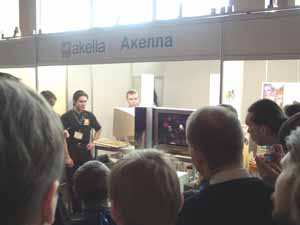 IntroductionThe second Game Developers Conference was held in Moscow in February, 20 - 22, 2004. I'm sure the net is overfilled with materials about this conference. And I think that most of them are devoted to PC games and technologies in this sphere (and the most part describes new games announced at this forum). I'm going to share my impressions from a standpoint of a card reviewer who keeps track of development of modern technologies in 3D graphics as there were a lot of seminars and lectures given at the conference. On the first day we had only chargeable master classes. The stands in the lobby were being erected, the representatives of the sponsor companies and organizers were dashing about the Kosmos hotel where the conference took place. A few rooms were taken for master classes held by the professional developers. One of them is famous John Romero! So, the main events started only on February 21. February 21OpeningWe arrived by 9 am, and passed the registration procedure. As we found out later, it took time to register all the pressmen because the throughput of one booth was too low, and the opening of the conference was delayed. Alexander Medvedev, Philipp Gerasimov and Aleksei Barkovoi (left to
right) represented iXBT.com there.
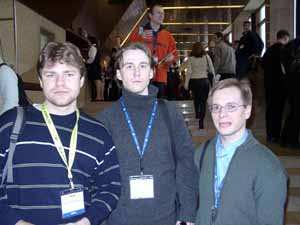 As well as your humble servant who couldn't pass by ATI's booth (like Alexander
Medvedev :):
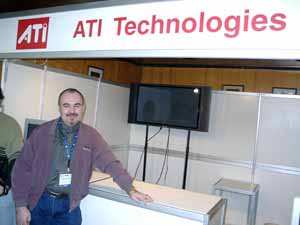
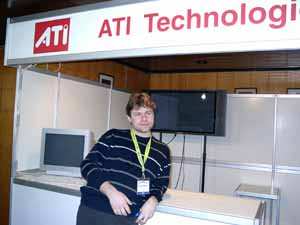 The guys representing ATI came here much later when the other booths were
overfilled with the visitors. By the way, here we met our colleagues: Ivan
Pritula (Guide3D), Dmitry Zinoviev (Ferra) and Aleksei Burdyko:
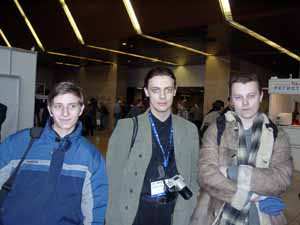 Konstantin Martynenko (Sapphire Technologies) arrived a little later, he
is actually a forefather of the 3D graphics section in Runet at Reactor
Critical site:
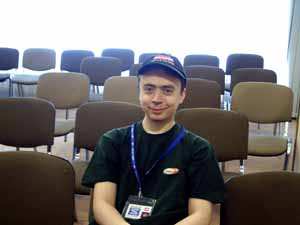 While the organizers were preparing the concert hall for the opening (which
didn't attract many people though as the stands were of much more interest
:) we had a chat with Guennadi Riguer from ATI Technologies (sitting on
the right):
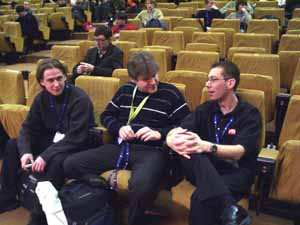 The first person that took the floor was Evgeny Maleev (DTF).
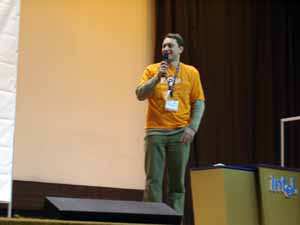 Then the floor was given to the organizers (Alexander Federov), sponsors,
in particular, to Intel (Dmitry Ilyin who spoke about much deeper integration
of Intel's new technologies, first of all, HyperThreading, in games) and
ATI (Guennadi Riguer). The last speakers were Tom Hall and John Romero
(ex-id Software, ex-ION Storm) from Midway Entertainment.
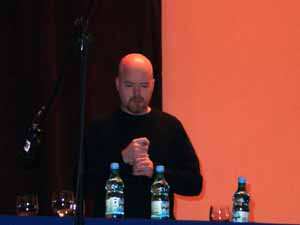
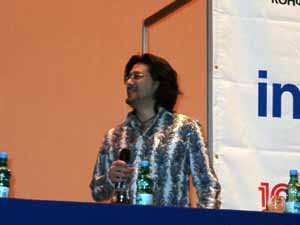 The conference program was overcrowded, two days (from 10 am to 6 pm) fit 77 lectures and seminars on 5-6 parallel streams! I visited only a part of them as I was mostly interested in technologies from the very developers, i.e. ATI (graphics sponsor of GDC) and NVIDIA. Judging by the program, the lion's share of the information environment was taken by ATI. NVIDIA held only three seminars on February 21. ATIThe Canadian company was represented by two bisons in 3D sphere - Richard
Haddy and Guennadi Riguer,
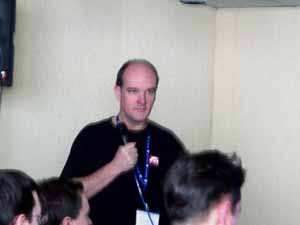
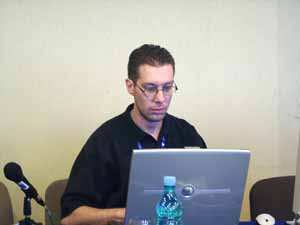 as well as by charming Natasha Tatarchuk,
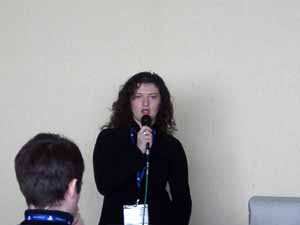 a great expert in 3D graphics. When Richard spoke Natasha also translated
his speech into Russian:
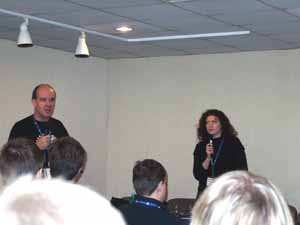 The first day was devoted to aspects of the current technologies. The discussion was about the RenderMonkey tools concerning their usage for GLSL (a higher-level language for programming shaders in OpenGL, the standard of which was recently ratified and which is already used in ATI's latest drivers; NVIDIA will also add it to its arsenal soon). Natasha Tatarchuk is a guru in RenderMonkey, and she conducted this part of the discussion. Guennadi Riguer's lecture of shader optimization was very useful for the game developers. A bit later, on February 22, we will have a closer look at ATI's materials :) NVIDIANVIDIA was represented by John Spitzer and Ashu Rage (John Spitzer on the
left, Ashu Rage below and Philipp Gerasimov on the right):
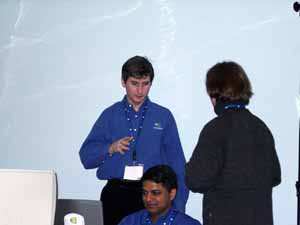 Ashu was first to take the scene
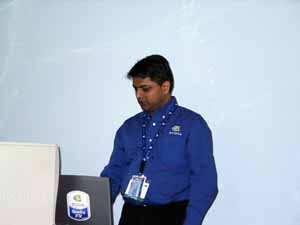 In general, he spoke about the support for developers and stressed on the tools in dealing with the FX format (FX Composer is the shader development and debugging environment like RenderMonkey with its own advantages, like the shading time estimation function on any NV3x video card) and described all functions and peculiarities in detail. It was interesting to see his demonstrations. John Spitzer held held a seminar on performance optimization,
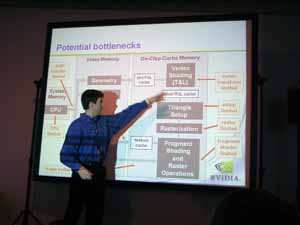 and first of all, he spoke about bottlenecks and the ways of working around
them.
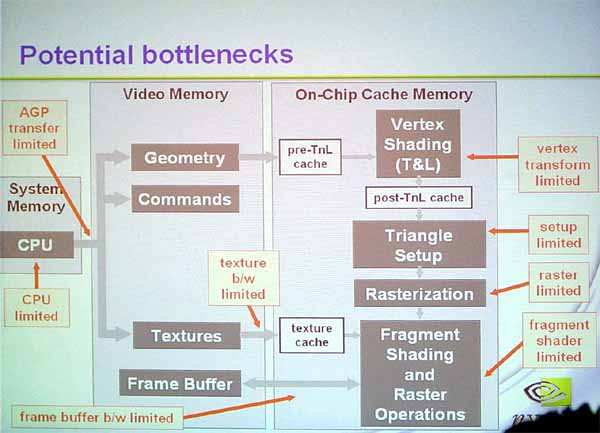 Note that the diagram of operation of a 3D accelerator is simplified: video memory is understood as video card's local memory and AGP memory. As you can see, the bottlenecks must be expected in the following sections:
That is why bottleneck identification is very important. John spent much
time for explaining the scheme of their identification asking the developers
to make the tools of enabling/disabling of such functions more flexible.
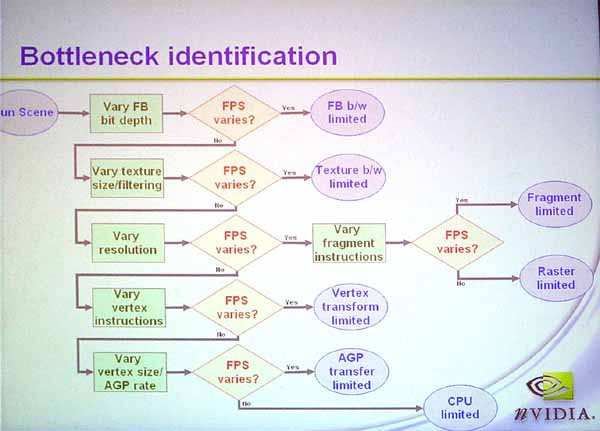 Yet at the game kernel development stage it's possible to reveal potential bottlenecks and conditions when the performance can drop. For example, there are some objects in the scene having the same texture. Does it make sense to select the same texture several time or it's better to focus on sorting the loop so that the program could use the texture once and treat caches more effectively? On the whole, I got a lot from the lecture (it was the first time I visited a lecture of this kind). Besides, I must give John his due because his speech was clear and unbroken. Mr. Spitzer was followed by Ashu Rage's lecture on fine issues of pixel shader optimization. After NVIDIA's seminars I returned to ATI's lectures. But before it
I had a nice dinner (thanks to the organizers!) and a chat near the booths.
In particular, I had a word with Guennadi Riguer from ATI (Guennadi and
Philipp Gerasimov on the left pic, Guennadi and Andrey Vorobiev on the
right pic):
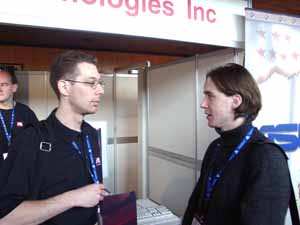
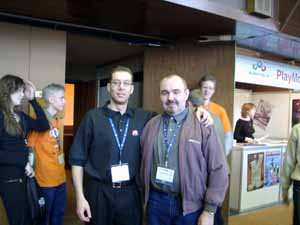 In the hall where the project fair was taking place John Romero was autographing:
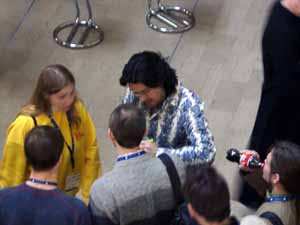 February 22ATIThat day ATI had a very crowded schedule because of multiple lectures and
seminars. Look how the RightMark3D (Alexander Medvedev and Philipp Gerasimov
being its developers) cast a shadow on the screen :):
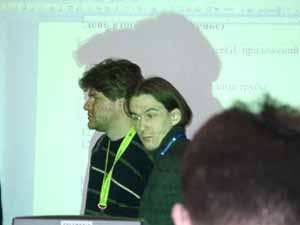
But the most interesting and long-awaited report was "What Comes After
9800?". The lecture was held by Richard Haddy. The hall was overcrowded,
some even had to stand. There were even very young guys there:
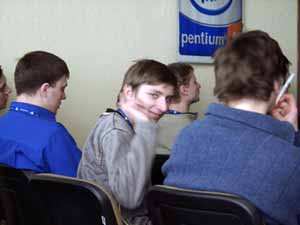
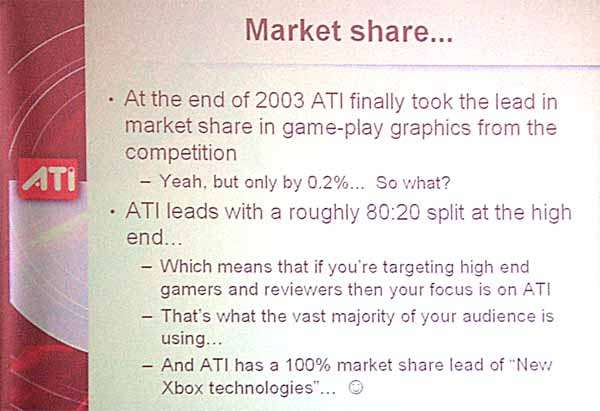 Richard didn't forget to mention about ATI's achievements: it's the first
time when ATI's marketshare beat NVIDIA's one. Although 0.2% doesn't look
that impressive, it indicates that ATI is far not a secondary player. Today
ATI is a leader in the High-End sphere, and when the XBox Next comes onto
the market, the developers will mostly use ATI's tools.
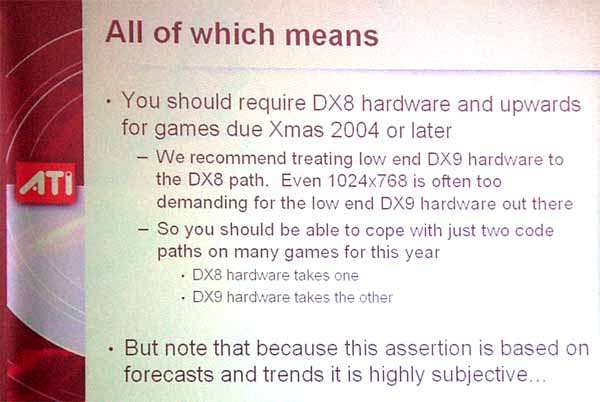
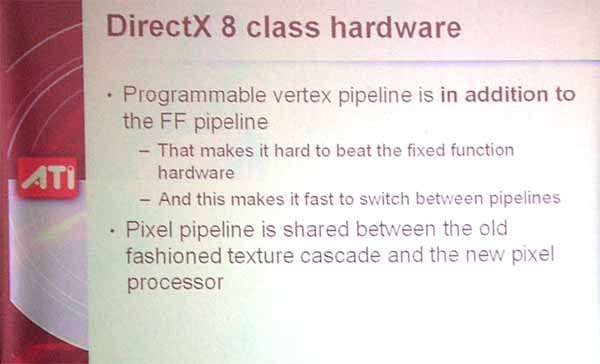
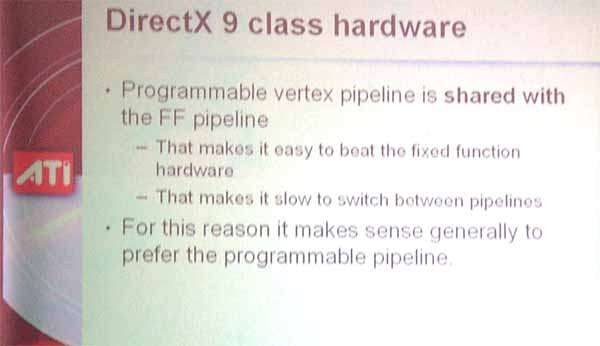 On the pics above you can see two slides where Richard paid attention to
the difference in realization of the TCL modules in R2xx and R3xx. While
in RADEON 8500-9100 the vertex shader unit and the fixed TCL one were two
different units, in RADEON 9500 and higher the fixed TCL module is emulated
with a shader. That is why R3xx benefit from vertex shaders optimized for
certain needs.
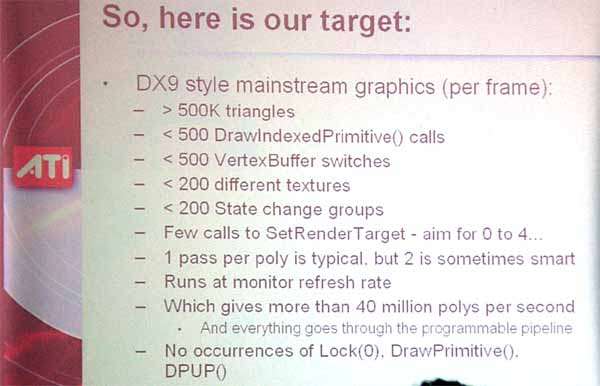 This slide demonstrates recommendations for DirectX API calls within which
video cards based on the latest GPUs (RADEON 9500-9800) can run optimally.
Although the slide refers to ATI's presentation, NVIDIA provides the same
recommendations for API.
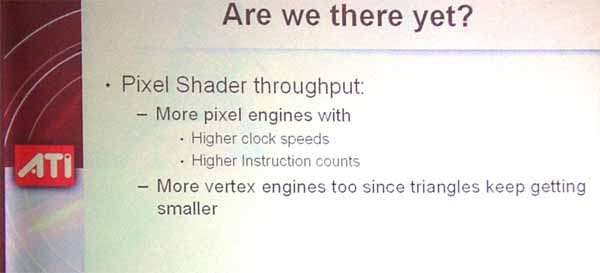 So, what's next for ATI? Undoubtedly, today's and future games will need some fillrate reserve, and the shader complexity will keep on growing. That is why the number of pixel pipelines will grow up simultaneously with the increase in clocks and weakening of limitations for the shader size. Vertex shaders will also increase in number because the average triangle size is getting smaller and the number of triangles in a frame is getting higher. Aleksei Barkovoi notes: Actually, I'm not sure whether this slide
refers to the current generation or to the next one!
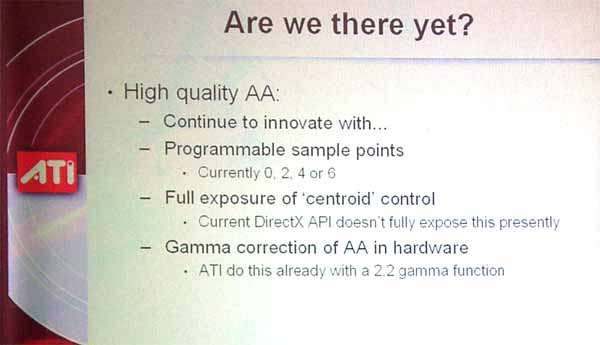 Richard once again mentioned the expanded functions available for the current generation of ATI's accelerators:
They also showed some interesting slides concerning future technologies. We will omit it today because soon we will publish Alexander Medvedev's article regarding DirectX Next (do not miss it!). An hour before Richard Haddy's speech, Guennadi Riguer spoke about Compression of maps of normals and introduced a new texture format for using compression of maps of normals. By the way, this seminar was in a certain way connected to the seminar of the effective usage of pixel shaders held by Ashu Rage from NVIDIA the day before. It shows what a great attention IHV pay to usage of maps of normals in modern games. Maps of normals produce beautiful images but they almost double the texture volume. Maps of normals which do not cause artifacts must be stored in textures of 8 bits per channels at least (RGB8), or better of 16 bits (G16R16), like in all ATI's demos. In order to make the texture volume smaller the company carried out some experiments with DXTn formats (lossy compression called S3TC in OpenGL) and found out that the DXT5 was the most optimal: in this format each of two coordinates (x, y) is stored in its channel: color and alpha. In this format the memory size required is 4 times lower (32 bits against 8 bits)! As the further extension, ATI will support a new format in its new chips. It's based on the DXTC and previously named ATI2N. It differs from DXT5 in compression of only a color component (out of three) using the method identical for the alpha channel compression. The new format will tremendously increase the precision of compressed texture storage compared to the DXT5, with the size being the same. That was ATI's seminar where the speaker dropped some hints at the future interesting technologies and extension of the current ones without naming definite terms or solutions. When it slipped out that video cards with 512 MB memory onboard will come this year Richard said that there was nothing more to be afraid of as he will get fired anyway :-) The final stage of the lectures and seminars brought about the discussion about the developers' current achievements, optimizations and debugging. FinalThe conference is over. Let me remind you once again that we came there to listen to lectures and take part in seminars held by ATI and NVIDIA, as well as interact with the developers. We couldn't visit all the lectures. If you are interested mostly in what benefit this conference brings to gamers and developers you'd better look for other reviews on the Net. The most vital conclusion is that ATI and NVIDIA, two leading graphics developers, actively support game developers, interact with them and try to mutually solve problems. Everyone is keen to see games working flawlessly, optimally and effectively. I liked the atmosphere ATI created by urging the visitors to write them about problems so that they could solve problems of both parties. There were also some curious incidents. Richard Haddy cracked a joke saying that if he got 50 games by e-mail he would be happy but the system administrators would be shocked. Then he mentioned that he would tell about a certain problem to.. the drivers. :) Yury Kryachko (1C) replied that now it was clear that ATI's drivers were self-made and self-debugged. :) It was a real pleasure to visit such a conference. Many thanks to the organizers and sponsors. It was especially pleasant to combine entertainment and use. In the end, here's a pic of John Romero embracing Philipp Gerasimov
:-)
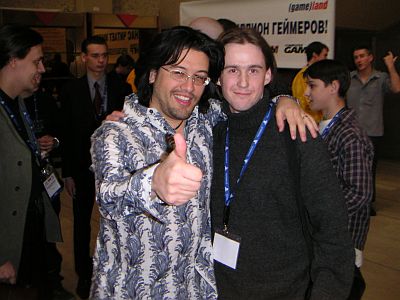
Andrey Vorobiev (anvakams@ixbt.com)
|
Platform · Video · Multimedia · Mobile · Other || About us & Privacy policy · Twitter · Facebook Copyright © Byrds Research & Publishing, Ltd., 1997–2011. All rights reserved. |